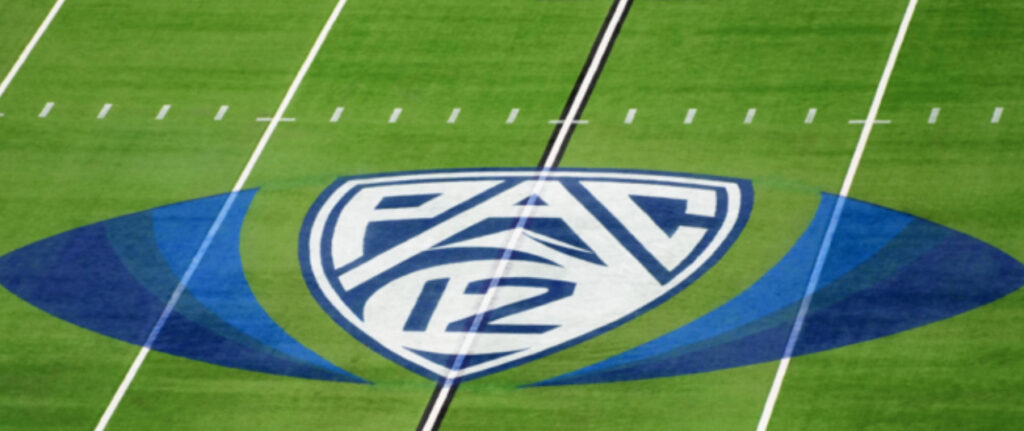How low would Oregon and Washington go, in terms of partial revenue shares, if the Big Ten comes a-calling? Why be a beta site for streaming college sporting events when you can be a ‘junior member’ of the Big Ten? — Jon Joseph
Your phrasing cuts right to the heart of the issue: Would Oregon and Washington accept being “junior members” of any conference?
We are highly skeptical, especially given that UCLA would have full membership despite possessing a lesser football program than the Pacific Northwest powers.
But there’s another piece to the discussion. And to be honest, the Hotline often feels like we’re in the wilderness on this matter while the public narrative focuses on the media revenue: The expanded College Football Playoff matters immensely in strategic decisions at the campus level.
Let’s say Pac-12 commissioner George Kliavkoff presents a media deal to the schools worth $30 million per campus.
Now, we have seen zero indication that Big Ten presidents are willing to expand again, unless Notre Dame is involved (By and large, the campuses were never on board with adding more West Coast teams. That was commissioner Kevin Warren’s personal aim, and his public pronouncements on the matter were one reason he had so little internal support.)
But for the sake of this exercise, we’ll presume the Big Ten comes to Oregon and Washington and offers partial shares at $35 million or $40 million per year.
Is that enough to counteract the competitive disadvantage that would come from switching conferences?
Forgive the oversimplification, but it reflects the calculation:
— In a Pac-12 that had either 10 or 12 schools and lacked USC, the Huskies and Ducks would be competing with each other and Utah for the automatic CFP bid.
— In an 18- or 20-team Big Ten, they would be competing with USC, Michigan, Ohio State, Penn State and others for the automatic bid.
(Yes, access to the CFP’s six at-large berths would have to be considered in both the Pac-12 and Big Ten, but those involve more variables.)
We believe the playoff matters a great deal to the Huskies and Ducks, particularly to a certain 85-year-old Oregon benefactor. Phil Knight wants to win a national championship.
And to a lesser degree, consider this: Playoff games hosted on campus would be momentous events for any school, with benefits for the entire university.
Let’s include Utah in this discussion, as well. If the Utes cast an eye to the future and expect college football to split into the haves and have-nots in the 2030s, the best way to elevate the Utah brand and eventually become a ‘have’ is to … participate in the playoff.
That’s far easier in the Pac-12 without USC than it would be in a 14- or 16-team Big 12.
Combine the psychological weight that comes with being a “junior member” in the Big Ten with greater playoff access in the Pac-12, and there’s a strong case to be made for the Ducks and Huskies staying right where they are.
Especially if the Pac-12 makes the smart move and creates a performance-based (i.e., unequal share) distribution model for postseason revenue.
Is there reason to believe that any Pac-12 schools have other legitimate options? Is the Big Ten willing to offer partial shares? Is the Big 12 able to offer full shares? Is independence an option for any school? — @Jalex0077
We addressed the Big Ten piece above, and the Independent path isn’t viable for any of the schools. The Big 12 option is available, but it would require some massaging.
Our understanding is the Big 12’s agreement with ESPN and Fox does not include a full pro-rata clause — meaning new members would not be contractually guaranteed to enter the conference with the same annual revenue share ($31.7 million) as the schools currently under contract.
That wouldn’t preclude ESPN and/or Fox from offering to make any new members whole, but it would require a negotiation.
And given that Fox has what it wants from the Pacific Time Zone — the Los Angeles market — the onus seemingly would be on ESPN to make the math work.
The Big Ten and SEC had 15 total NCAA Tournament bids and didn’t send anyone to the Final Four. We keep hearing about the financial gap widening. When will that gap translate to tournament dominance, if ever? — @IceDevilCA
Excellent question, and one that can be summed up in this manner: Basketball and football have completely different economic models.
Football is capitalism. Immense resources are required to build a program that can recruit the players needed to succeed at the highest level.
Basketball is socialism, especially with the single-elimination nature of the NCAA Tournament. One or two good players and a weekend of hot shooting can propel a No. 9 seed into the Final Four.
Within that economic difference is the stark contrast in the talent pipelines.
There are plenty of 6-foot-7 kids across the country who can learn to shoot 3-pointers at an effective rate. There are very few 300-pound defensive linemen with the athleticism to be impact players.
The schools with the resources are more likely to land those blue-chip linemen.
Is Apple the leader right now in buying the Pac-12 media rights? If so, which linear providers are they most likely to partner with? — @flintaeroinc
I cannot confirm Apple’s position as the theoretical “leader” with any more certainty than I could confirm ESPN or Amazon.
But the ongoing narrative on social media and in media reports about the Pac-12 opting for an all-streaming deal is wholly misguided, in our opinion.
There is zero indication the conference will place all its football games on a streaming service; there will be a linear component, likely on ESPN/ABC.
Even if Apple or Amazon purchased everything, the agreement would undoubtedly be a sub-licensing deal that placed football games on a linear platform.
Boise State is a better cultural and academic fit with the Big 12 than the Pac-12. In the Hotline’s view, where does BSU fall when the realignment window closes? — @DamonDennett
The Hotline concurs about the conference fit: Boise State is better suited for the Big 12 than the Pac-12. But that doesn’t mean it’s an ideal addition for the Big 12.
The media market is small, the basketball program is solid but not high-end, and football has lost needle-moving relevance over the years.
In our view, Boise State isn’t moving. The Broncos will be part of the Mountain West’s next chapter, in whatever form it takes.
Does Fresno State make sense as a Pac-12 expansion candidate to keep the Big 12 out of the California footprint? — @atqdave
Yes, but not to the extent that San Diego State is vital as a defensive play.
Fresno is located in the Central Valley, which is important for the Pac-12 but not strategically critical for media or recruiting exposure, in our view.
It’s 250 miles from Santa Ana, for example, where prep powerhouse Mater Dei High School is located.
San Diego is effectively part of the Southern California media market and only 90 miles from Mater Dei.
Additionally, Fresno State’s academic profile probably doesn’t meet the standard set by the Pac-12 presidents, whereas SDSU, which can now award doctorate degrees, seemingly clears the bar.
Hypothetical situation: Tulane is seen as Team 13 by the Pac-12. Who do you think is best fit for Team 14? Fresno State, Colorado State, or anyone else? — @OS_Beaver
In that situation, Rice would be the clear frontrunner as No. 14. If you add Dallas (SMU) and New Orleans (Tulane), it only makes sense to include Houston (Rice) in the expansion.
What’s more, Tulane and Rice work academically: The former is No. 44 in the U.S. News and World Report rankings; the latter is No. 15.
Both are members of the prestigious Association of American Universities.
Both are R1 research schools.
Academically, they are no-brainers. But are they financially additive? They would add inventory in the Central Time Zone, but that’s only part of the valuation calculation.
And do they clear the bar competitively? You could make the case for Tulane, perhaps, but Rice is a stretch.
Adding campuses in Dallas, Houston and New Orleans massively expands the footprint of the conference, and I’m not convinced the presidents are interested in that strategic outcome.
So while it’s fascinating to contemplate, we are extremely skeptical that the Pac-12 would add more than two members.
Where do you believe the Arizona Wildcats end up? Are there any schools that could join the Pac-12 that would change the minds of schools that are considering leaving? — @J_Cuda90
As the Hotline has noted repeatedly, the 2030s could bring a seismic shift in the structure of major college sports. But for the near term, the most likely outcome for Arizona is membership in the Pac-12.
And while there are no schools available that make the Pac-12 markedly more attractive, San Diego State’s performance in the NCAA Tournament certainly improves the perception of the Aztecs as a member.
Basketball doesn’t have the same impact as football. But it’s not meaningless, especially with the loss of a tentpole program (UCLA) and the other benefits SDSU would bring (with geography atop that list).
Bottom line: Perception matters, and the optics of adding SDSU have improved for the conference.
Is the faith and trust given to commissioner George Kliavkoff and his team by the presidents, athletic directors and media warranted? Seems his 21 months on the job are void of accomplishments in this field, but include several gaffes. — @D1963Mr
Kliavkoff was hired to usher the conference into a new era, with the media rights agreement as the centerpiece. He was dealt a bad hand and then lost the L.A. schools, but the endgame hasn’t changed:
— If he crafts a media deal that keeps the conference together, the trust is warranted (although the specifics of the agreement would add nuance to the assessment).
— If he doesn’t, the conference will cease to exist, he’ll be out of a job, and his tenure will be deemed catastrophic.
We continue to believe survival is more likely.
Why not a Pac-8? Quality over quantity might increase payouts on a per-school basis. Cutting Oregon State and Washington State and replacing Cal with San Diego State would also reduce inventory, for which Amazon and ESPN don’t appear keen. — Yoni Cohen
Nobody is getting “cut.” No school has ever been booted from a conference because it wasn’t deemed valuable enough. The intra-state politics simply wouldn’t allow it.
However, the quality/quantity calculation is central to the expansion decision.
The remaining 10 schools could decide they are better off competitively and financially by standing down — that splitting the pie 12 ways isn’t worthwhile, even if the new schools enter at reduced revenue shares.
We believe expansion is more likely than not, especially with San Diego State’s Final Four appearance as the backdrop. But until the presidents vote to add members, we are left to guess.
Let’s play pretend and say the Pac-12 has blown up and ceases to exist. What happens to the Hotline? — Marshall Brown
Appreciate the interest.
The Hotline isn’t going anywhere. We cover the schools and the issues that matter to them, regardless of conference affiliation.
*** Send suggestions, comments and tips (confidentiality guaranteed) to pac12hotline@bayareanewsgroup.com or call 408-920-5716
*** Follow me on Twitter: @WilnerHotline
*** Pac-12 Hotline is not endorsed or sponsored by the Pac-12 Conference, and the views expressed herein do not necessarily reflect the views of the Conference.
Related posts:

(AP Photo/Ralph Freso, File)
Pac-12 Networks financial mess: The partner in question, annual revenue numbers, Scott lays low and more on the timeline The Pac-12 top 10: Key news developments from the week include Dickert’s deal, Pac-12 Network future, coaches contract lined up , more
The Pac-12 top 10: Key news developments from the week include Dickert’s deal, Pac-12 Network future, coaches contract lined up , more
 Pac-12 media rights: University presidents issue statement of unity as process churns on
Pac-12 media rights: University presidents issue statement of unity as process churns on
 Congrats to Jon Wilner! Pac-12 Hotline reporter honored among 2022’s best national sports writers
Congrats to Jon Wilner! Pac-12 Hotline reporter honored among 2022’s best national sports writers
Jon Wilner
Jon Wilner has been covering college sports for decades and is an AP top-25 football and basketball voter as well as a Heisman Trophy voter. He was named Beat Writer of the Year in 2013 by the Football Writers Association of America for his coverage of the Pac-12, won first place for feature writing in 2016 in the Associated Press Sports Editors writing contest and is a five-time APSE honoree.

